
iodine clock reaction experiment pdf
The iodine clock reaction is a classic chemical demonstration showcasing reaction kinetics. It involves iodine, hydrogen peroxide, and starch, causing a sudden color change from colorless to blue. This visually striking experiment illustrates redox reactions and time-dependent processes, making it an engaging tool for teaching chemical kinetics and reaction mechanisms;
Overview of the Experiment
The iodine clock reaction experiment involves mixing hydrogen peroxide, potassium iodide, starch, and sodium thiosulfate. Initially, the solution appears colorless, but over time, it suddenly turns dark blue due to the formation of the starch-iodine complex.
This reaction demonstrates a time-dependent chemical process, where the delay before the color change depends on reactant concentrations and catalysts. It is widely used to teach chemical kinetics, reaction rates, and redox mechanisms in an engaging and visually striking manner.
Historical Background and Discovery
The iodine clock reaction was first discovered by Hans Heinrich Landolt in 1886, who observed the sudden color change in iodine solutions. His work laid the foundation for understanding reaction kinetics. The experiment gained popularity as a teaching tool due to its dramatic visual effects and ability to demonstrate time-dependent chemical processes.
Landolt’s discovery highlighted the role of starch as an indicator, enabling the clear observation of iodine formation. This innovation made the reaction accessible for educational purposes, showcasing the principles of redox reactions and catalysis in a practical setting.
Educational Value and Relevance
The iodine clock reaction is a valuable educational tool for teaching chemical kinetics, reaction rates, and redox processes. It provides a visually engaging demonstration of time-dependent reactions, making complex concepts accessible to students. The experiment aligns with curriculum requirements, offering practical insights into reaction mechanisms and the role of catalysts. Its simplicity and safety make it ideal for classroom settings, allowing students to observe and measure chemical changes firsthand, fostering a deeper understanding of chemistry principles.
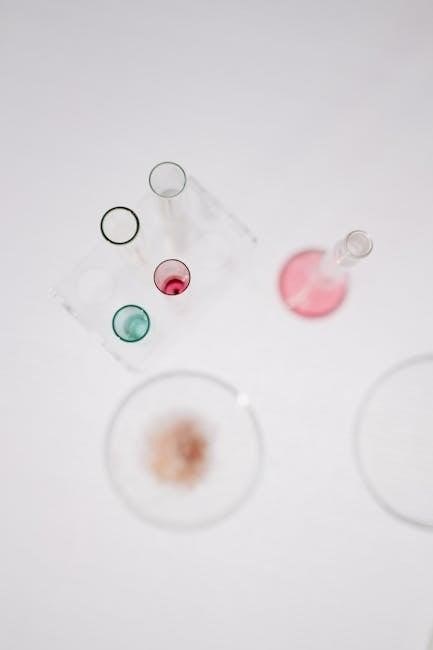
Chemical Reactions Involved
The iodine clock reaction involves oxidation-reduction processes where iodine is produced and reacts with thiosulfate. The reaction sequence includes iodide oxidation to iodine and its subsequent reaction with thiosulfate, leading to a visible color change when iodine interacts with starch.
The Redox Reaction Mechanism
The iodine clock reaction involves a two-step redox mechanism. First, iodide ions (I⁻) are oxidized by an oxidizing agent, typically potassium bromate (KBrO₃) or hydrogen peroxide (H₂O₂), producing iodine (I₂). In the second step, iodine reacts with sodium thiosulfate (Na₂S₂O₃), reducing iodine to iodide ions while thiosulfate is oxidized to tetrathionate (S₄O₆²⁻). Starch, acting as an indicator, forms a blue complex with iodine, allowing the reaction progress to be visually monitored until the iodine is consumed.
Role of Starch as an Indicator
Starch plays a crucial role as an indicator in the iodine clock reaction. It forms a deep blue complex with iodine, making the color change visible and distinct. When iodine is produced, it binds with starch, turning the solution blue. This color change signals the end of the reaction, as it indicates the presence of iodine. The intensity of the blue color correlates with the concentration of iodine, providing a clear visual endpoint for the reaction.
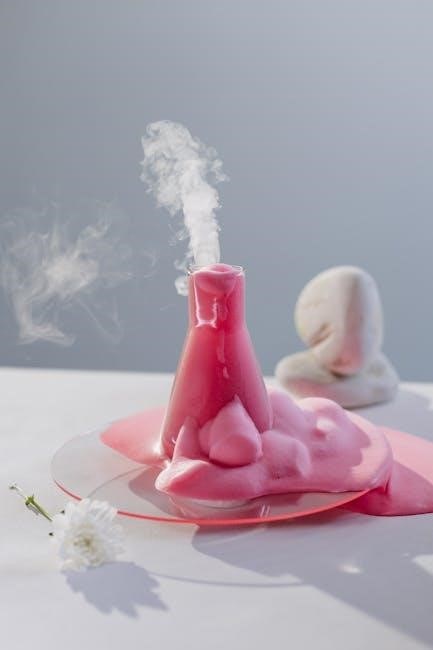
Materials and Equipment Needed
- Hydrogen peroxide, potassium iodide, and starch solution.
- Beakers, graduated cylinders, and a thermometer for precise measurements.
- Gloves, goggles, and lab coats for safety.
Chemicals Required
The iodine clock reaction requires specific chemicals to initiate and observe the reaction. These include hydrogen peroxide (H₂O₂), potassium iodide (KI), and starch solution for the color change. Sodium thiosulfate (Na₂S₂O₃) acts as a reducing agent, while sulfuric acid (H₂SO₄) is used to acidify the solution. The reaction also involves iron(II) sulfate as a catalyst and oxalic acid to activate it. All chemicals must be of analytical grade to ensure accurate results. Proper handling and storage are essential due to their reactive nature.
Lab Equipment and Safety Gear
Conducting the iodine clock reaction requires essential lab equipment such as burettes, beakers, measuring cylinders, and stirrers. Thermometers and stopwatches are used to monitor temperature and reaction time. Safety gear, including gloves, goggles, and lab coats, is crucial to protect against chemical splashes. A well-ventilated workspace or fume hood is recommended to handle potentially hazardous vapors. Ensure all equipment is clean and accurately calibrated for precise measurements. Proper setup and safety precautions are vital for a successful and safe experiment.

Step-by-Step Procedure
Mix hydrogen peroxide and potassium iodide, then add starch and sodium thiosulfate. Observe the colorless solution turn blue upon reaction completion.
Preparation of Solutions
Dissolve potassium iodide in water to create an iodide solution. Mix hydrogen peroxide with sulfuric acid for the oxidizing agent. Prepare a starch solution by boiling starch in water until clear. Dissolve sodium thiosulfate separately. These solutions are mixed in specific ratios to initiate the reaction, with concentrations adjusted to study reaction rates. Proper preparation ensures precise chemical interactions, crucial for observing the color change and timing the reaction accurately.
Mixing Reactants and Observing the Reaction
Combine the iodide and hydrogen peroxide solutions in a beaker. Add starch and thiosulfate, mixing thoroughly. Initially colorless, the solution remains clear as thiosulfate consumes iodine. Once depleted, free iodine reacts with starch, turning the solution blue. The delay before color change allows measurement of reaction time, demonstrating kinetic principles. Observing this transformation provides a clear visual endpoint, enabling students to study how variables like concentration and catalysts influence reaction rates in a controlled laboratory setting.
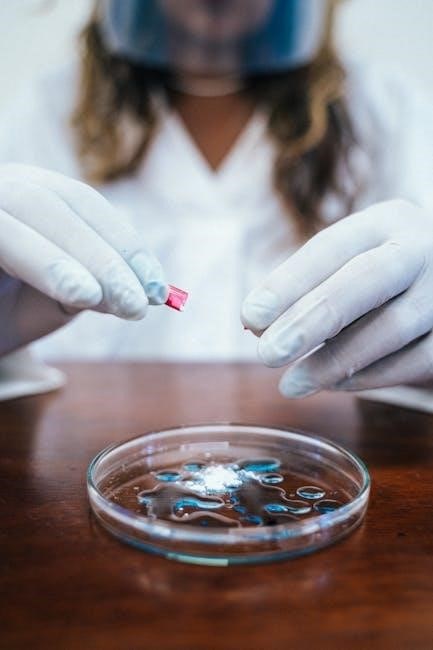
Factors Affecting the Reaction Rate
Concentration, temperature, and catalysts significantly influence the iodine clock reaction. Higher concentrations and temperatures accelerate the reaction, while iron(II) and oxalate act as catalysts, enhancing the rate of iodine formation.
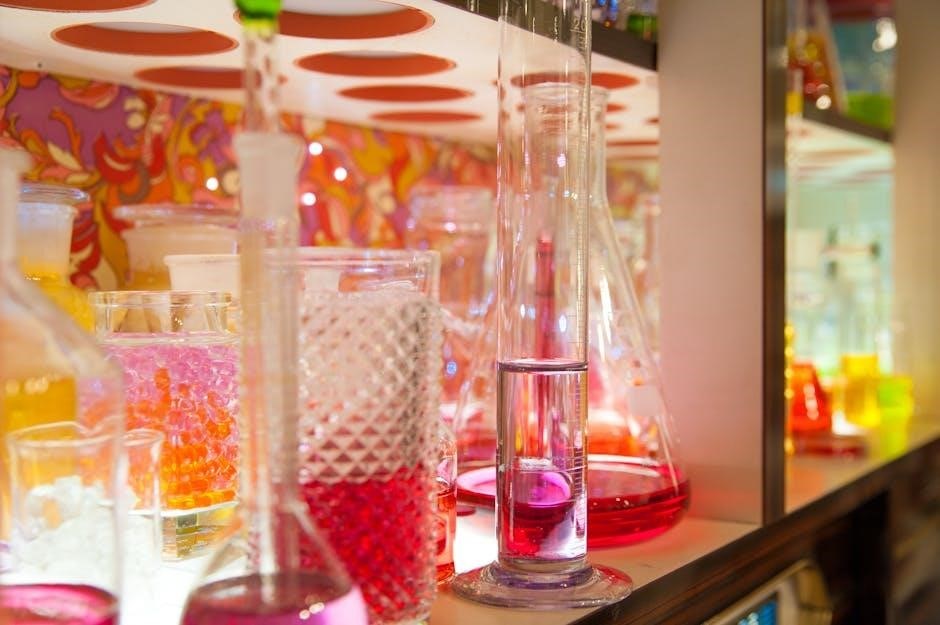
Concentration, Temperature, and Catalysts
The iodine clock reaction rate is influenced by concentration, temperature, and catalysts. Increasing reactant concentration or temperature accelerates the reaction, while catalysts like iron(II) and oxalate enhance the oxidation of iodide. Higher concentrations of hydrogen peroxide or potassium iodide speed up the reaction, and elevated temperatures increase molecular collisions, accelerating the process. Catalysts lower activation energy, making the reaction proceed faster. These factors provide insights into how kinetic principles control the timing of the color change, allowing precise studies of reaction dynamics and mechanisms.

Observations and Results
The iodine clock reaction exhibits a dramatic color change from colorless to dark blue when iodine reacts with starch. The timing varies based on concentration and catalysts, with higher concentrations or temperatures reducing the reaction time. This visible transformation demonstrates the reaction’s progress and the principles of chemical kinetics effectively.
Color Change and Timing
The iodine clock reaction is characterized by a sudden and dramatic color change from colorless to dark blue. This occurs when iodine reacts with starch to form a blue complex. The timing of this transformation depends on the concentrations of reactants and the presence of catalysts. Higher concentrations or temperatures accelerate the reaction, reducing the time before the color change. This visible indicator allows for precise measurement of reaction rates, making it a compelling demonstration of chemical kinetics in action. The predictable timing also highlights the reaction’s sensitivity to experimental conditions.

Safety Considerations and Disposal
Handle strong acids like sulfuric acid and hydrogen peroxide with care, as they are corrosive. Wear protective gloves, goggles, and lab coats. Iodine solutions and potassium iodide can cause skin irritation. Dispose of all chemical waste according to lab protocols, neutralizing acidic solutions with a base like sodium bicarbonate. Contaminated materials should be placed in designated hazardous waste containers. Ensure the lab is well-ventilated to prevent inhalation of fumes. Proper cleanup and disposal are crucial to prevent environmental harm and ensure a safe working environment for everyone involved in the experiment.
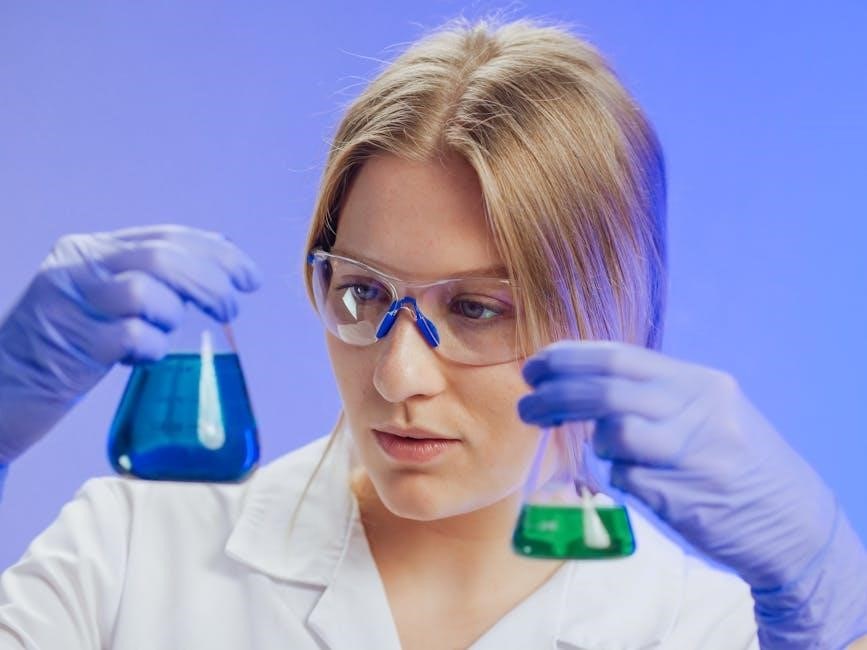
Teaching and Learning the Experiment
Tips for Conducting the Experiment in a Classroom
The iodine clock reaction is a hands-on learning tool for teaching chemical kinetics. Its visual nature makes complex concepts engaging, suitable for both students and educators.
Tips for Conducting the Experiment in a Classroom
Use household chemicals like vitamin C for a safer, cost-effective approach. Ensure students wear safety goggles and gloves. Pre-measure solutions to save time during the session. Emphasize the role of starch as an indicator, as it forms a blue complex with iodine. Demonstrate the reaction once before student groups begin. Encourage timing the reaction to discuss concentration and catalyst effects. Highlight the importance of precise measurements for consistent results. Use stopwatches to measure the time accurately. Discuss safety protocols and waste disposal procedures thoroughly.

Variations and Extensions
Explore alternative catalysts like iron(II) and oxalate, substitute starch with cellulose paper, or use household chemicals like sulfite. Vary concentrations, temperatures, or oxidizing agents creatively.
Modified Versions and Alternative Catalysts
Modified versions of the iodine clock experiment replace starch with cellulose paper for better visibility of the color change. Alternative catalysts such as iron(II) and oxalate can be used to alter the reaction rate. Iron(II) catalyzes the oxidation of iodide, while oxalate acts as an activator. These modifications allow for a clearer observation of the reaction’s progression and provide insights into how different catalysts influence the reaction’s speed and efficiency.